soldiers
 Unfortunately, we don’t live in a world without wars, so our soldiers are a vital part of our national security. Of course, we hope and pray that all of our soldiers will eventually come home from war, be discharged from military service, and become veterans. Sadly that is not always the case. For those who do not come home, we have Memorial Day, to honor their memory. Veteran’s Day, however, is a day to honor those who served, and then came home and went back to their lives. For those who are veterans, we take this opportunity to thank them for their service and their sacrifice, because they did sacrifice. They left their families at home, and went out to fight for people they don’t even know, and probably never will. We, here at home, have no way to really repay them for their acts of selflessness, so all we can do is thank them for their service. Somehow, it just doesn’t seem enough. How could we possibly repay them? We can never give them back the lost time with family, the memories, the births of children, and the multiple firsts that go with them. Those things are gone forever for the soldier, because they chose to go out and protect their country, and the people in it.
Unfortunately, we don’t live in a world without wars, so our soldiers are a vital part of our national security. Of course, we hope and pray that all of our soldiers will eventually come home from war, be discharged from military service, and become veterans. Sadly that is not always the case. For those who do not come home, we have Memorial Day, to honor their memory. Veteran’s Day, however, is a day to honor those who served, and then came home and went back to their lives. For those who are veterans, we take this opportunity to thank them for their service and their sacrifice, because they did sacrifice. They left their families at home, and went out to fight for people they don’t even know, and probably never will. We, here at home, have no way to really repay them for their acts of selflessness, so all we can do is thank them for their service. Somehow, it just doesn’t seem enough. How could we possibly repay them? We can never give them back the lost time with family, the memories, the births of children, and the multiple firsts that go with them. Those things are gone forever for the soldier, because they chose to go out and protect their country, and the people in it.
Our soldiers are an amazing group of people…the best in the world. They have blessed the people of this nation in so many ways. Their service goes beyond just fighting a war. They show kindness to the people in war ravaged countries, sometimes risking their own lives to do so. The biggest problems with civilians in war zones,  is that you never truly know if the people you meet need help, or if they are out to kill you. Nevertheless, our soldiers set aside the worries and fears, and go out to do their duty. That is what makes us proud. We wish it was unnecessary for them to go, but we are thankful when they do, because we know that we are safer.
is that you never truly know if the people you meet need help, or if they are out to kill you. Nevertheless, our soldiers set aside the worries and fears, and go out to do their duty. That is what makes us proud. We wish it was unnecessary for them to go, but we are thankful when they do, because we know that we are safer.
I wish all our soldiers could come home and that peace on earth could become a reality, but that is not to be. Nevertheless, to all our veterans, I thank you for your time in the service. We would not be where we ar today without you. Happy Veterans Day to all of you, from a grateful nation!!
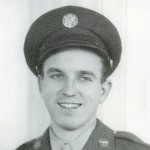
 As I have researched the infantry soldiers of World War II, my thought was that I was really thankful that my dad, Allen Spencer was not one of those men on the ground during the fighting. I felt bad for those men who were on the ground, fighting from the foxholes. I still do, because they were in constant danger. Bombs fall from the sky, and bullets fly from across the battlefield. If those things didn’t kill a soldier, the freezing cold, trench foot, or dysentery from the horribly unsanitary conditions could. It seemed that my dad’s situation was by far safer, but now, I’m not so sure that’s true.
As I have researched the infantry soldiers of World War II, my thought was that I was really thankful that my dad, Allen Spencer was not one of those men on the ground during the fighting. I felt bad for those men who were on the ground, fighting from the foxholes. I still do, because they were in constant danger. Bombs fall from the sky, and bullets fly from across the battlefield. If those things didn’t kill a soldier, the freezing cold, trench foot, or dysentery from the horribly unsanitary conditions could. It seemed that my dad’s situation was by far safer, but now, I’m not so sure that’s true.
The book I had been listening to, that took in World War II from D-Day to The Battle of the Bulge, talked mostly about the ground war, but then at the end, the reader said something that really struck me. It was about the look that crossed the face of a bomber crew’s faces before certain missions…those that would inevitably find the plane flying through flak. The look was one of fear. I knew flak was dangerous, but somehow I didn’t really connect flak with bringing down a plane, or seriously injuring its occupants. Nevertheless, it is quite dangerous for them.
As I researched the dangers of flak, a shocking revelation made itself known. I had written a story about the life expectancy of the ball turret gunner. My findings were that that life expectancy was about 12 seconds. That may be true when one is talking about the prospect of being shot, but when it comes to flak, that cannot be said. Apparently, where flak is concerned, the best place to be is in the plexiglass structure of the ball turret. Plexiglass holds up better against flak than other areas of the plane, so the ball turret gunner is much more protected…at least from flak. The same cannot be said for the bullets flying through the area. I was thankful that my dad was not a ball turret gunner, and that he only filled in as a waist gunner periodically. The waist gunners were in the open, where protection from bullets, and from flak was minimal…at best, non-existent at worst. I can’t imagine how those memories must have affected my dad, but in the book I listened to, the main reason many of the men didn’t want to talk about their experiences in World War II, or any war, was because talking about it brought those memories flooding in again.
After researching flak, and how it works, I can see why the men would get a look of fear on their faces as they prepared to go through areas anti-aircraft weapons shooting flak into the air. Some men said that they could see the red hot glow in the center of the flak, if it was very close. That tells me that it was like a small explosive devise. No wonder it could bring so much damage to a plane. I had known that flak could put holes in the fuselage, but somehow I hadn’t tied that with bringing down a plane. I surmise that it was the B-17 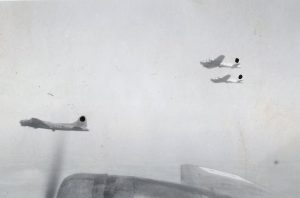
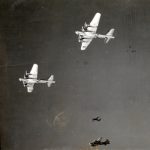 bomber top turret gunner’s daughter in me that wouldn’t allow me to place that danger around my dad. I didn’t want to think about the dangers of his every mission in World War II. My mind seems to have placed his plane in a bubble or a force field, so that no danger could come near him. I think every veteran wonders why they were spared, when others didn’t make it back home. I don’t think anyone can answer that question. As a Christian, I have to credit God for bringing my future dad home.
bomber top turret gunner’s daughter in me that wouldn’t allow me to place that danger around my dad. I didn’t want to think about the dangers of his every mission in World War II. My mind seems to have placed his plane in a bubble or a force field, so that no danger could come near him. I think every veteran wonders why they were spared, when others didn’t make it back home. I don’t think anyone can answer that question. As a Christian, I have to credit God for bringing my future dad home.

 World War II had dragged on for almost six years, when the United States took things to the next, and as it turns out, final level. For quite some time, Japan had been one of the forces to be reckoned with. Now, with so much new technology, a plan has begun to form to put an end to this war, once and for all. The Japanese had no idea what was coming…how the 6th of August, 1945 would change things forever.
World War II had dragged on for almost six years, when the United States took things to the next, and as it turns out, final level. For quite some time, Japan had been one of the forces to be reckoned with. Now, with so much new technology, a plan has begun to form to put an end to this war, once and for all. The Japanese had no idea what was coming…how the 6th of August, 1945 would change things forever.
That August 6th in 1945 dawned like any other day, but at it’s end, the world would find that everything had changed. The power to destroy whole cities in an instant was in our hands. At 8:16am, an American B-29 bomber dropped the world’s first deployed atomic bomb over the Japanese city of Hiroshima. The ensuing explosion wiped out 90 percent of the city and immediately killed 80,000 people. Tens of thousands more would later die of radiation exposure. Three days later, on August 9, 1945, a second B-29 dropped another 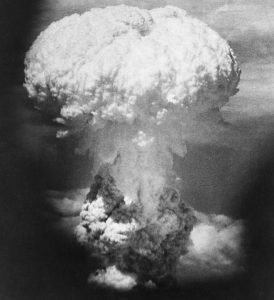 A-bomb on Nagasaki, killing an estimated 40,000 people. With these two events, it was very clear that the nations had the ability to bring mass destruction. Hopefully, they would also have the compassion, not to do it.
A-bomb on Nagasaki, killing an estimated 40,000 people. With these two events, it was very clear that the nations had the ability to bring mass destruction. Hopefully, they would also have the compassion, not to do it.
With such a show of power, Japan’s Emperor Hirohito announced his country’s unconditional surrender to the Japanese people in World War II in a radio address on August 14th, citing the devastating power of “a new and most cruel bomb” as the reason Japan could no longer stand against the Allies. I’m sure the war-ravaged people of Japan were almost relieved. Of course, that meant that they did not know what their future would bring, but the recent past hadn’t been so great either, so they didn’t have too much to lose really.
Japan’s War Council, urged by Emperor Hirohito, submitted a formal declaration of surrender to the Allies, on August 10, but the fighting continued between the Japanese and the Soviets in Manchuria and between the Japanese and the United States in the South Pacific. During that time, a Japanese submarine attacked the Oak Hill, an American landing ship, and the Thomas F. Nickel, an American destroyer, both east of Okinawa. On August 14, when Japanese radio announced that an Imperial Proclamation was coming soon, in which Japan would accept the terms of unconditional surrender drawn up at the Potsdam Conference. The news did not go over well. More than 1,000 Japanese soldiers stormed the Imperial Palace in an attempt to find the 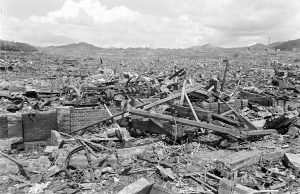
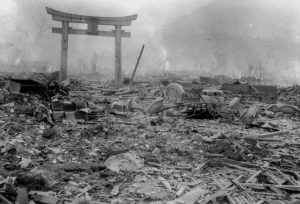 proclamation and prevent its being transmitted to the Allies. Soldiers still loyal to Emperor Hirohito held off the attackers. That evening, General Anami, the member of the War Council most adamant against surrender, committed suicide. His reason was to atone for the Japanese army’s defeat, and he refused to hear his emperor speak the words of surrender. I guess the surrender was not a relief to everyone.
proclamation and prevent its being transmitted to the Allies. Soldiers still loyal to Emperor Hirohito held off the attackers. That evening, General Anami, the member of the War Council most adamant against surrender, committed suicide. His reason was to atone for the Japanese army’s defeat, and he refused to hear his emperor speak the words of surrender. I guess the surrender was not a relief to everyone.

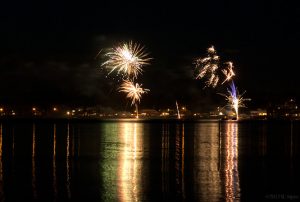 For many years, my husband, Bob Schulenberg and I have gone to the Black Hills to celebrate Independence Day. It has been our tradition for about 30 years. This year, things got changed up a bit. Our daughter, Amy Royce and her husband Travis invited us to come to Washington to spend the holiday with them. We will be watching the fireworks display at Semiahmoo Bay on the 4th. Bob and I went there a couple of years ago when we spent Thanksgiving with Amy’s family. The bay is beautiful, and I’m sure it will be even more fun in the summertime warmth…although it wasn’t very cold in November. We have never seen fireworks set off over water, so that will definitely be something new, and something about which we are very excited.
For many years, my husband, Bob Schulenberg and I have gone to the Black Hills to celebrate Independence Day. It has been our tradition for about 30 years. This year, things got changed up a bit. Our daughter, Amy Royce and her husband Travis invited us to come to Washington to spend the holiday with them. We will be watching the fireworks display at Semiahmoo Bay on the 4th. Bob and I went there a couple of years ago when we spent Thanksgiving with Amy’s family. The bay is beautiful, and I’m sure it will be even more fun in the summertime warmth…although it wasn’t very cold in November. We have never seen fireworks set off over water, so that will definitely be something new, and something about which we are very excited.
Celebrating our nation’s independence has always been a favorite holiday for Bob and me. We love everything about it. The fireworks take my thoughts back to history lessons, of the Revolutionary War. The rockets shot at ships, and the fighting that took place because we were a nation ready to be our own country. The fighting was sometimes brutal, but it was necessary. The patriots willingly gave their lives for the cause of independence. The fighting took place on land and water, and yet we have never seen fireworks over the water…until now. In my mind, I can see the ships from the Revolutionary War out in the bay. I can imagine the fireworks are the rockets, and the war is real. Nevertheless, I am glad that it isn’t really real, because I would not want our soldiers to have to relive that, but I can feel like a mouse in the corner, watching as history unfolds in front of my eyes…at least I can imagine it.
Of course, the fireworks aren’t the real thing, but rather just reminder of what our nation and the soldiers who fought for our independence, went through. My imagination of happened is just that…a figment of my imagination, because those events are long in the past. Still, I don’t believe that we should ever forget the lessons of war. There is always a reason we go to war…a wrong that must be made right, tyranny that must be stopped, killing that must be squashed, and slaves who must be made free. Good nations don’t go to war for 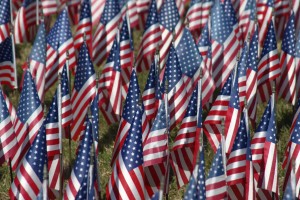
 evil purposes. I believe that the most important lesson to be taken away from any war, is that we must never trust our enemies, and even more importantly, we must never allow the enemy to infiltrate our nation and our government. Happy Independence Day to our great nation…the United States of America. Forever may our flag fly and forever may our nation stand.
evil purposes. I believe that the most important lesson to be taken away from any war, is that we must never trust our enemies, and even more importantly, we must never allow the enemy to infiltrate our nation and our government. Happy Independence Day to our great nation…the United States of America. Forever may our flag fly and forever may our nation stand.
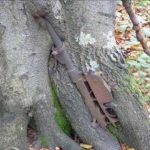
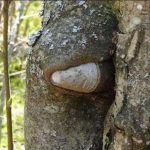
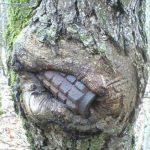 In any war, when soldiers are killed or wounded in battle, their guns, grenades, and bullets were left behind…forgotten. Those who assisted the wounded and carried off the dead, had more important things to attend to than the soldier’s weapons and such, which were simply left behind…discarded. As the front lines shifted from one area to another, battlefields were deserted, and in the absence of the trampling footsteps of the soldiers, the grass and low plants began to grow again. As the months and years passed, trees continued to grow. The littered items somehow became embedded in the bark of the growing trees. That phenomena has always amazed me. How could the tree bark accept this odd foreign object into itself…and yet it did. Of course, it was not without scars that the odd pair would coexist. The foreign items would be wrapped with a knotted looking bulge, or would appear to eat up portions of the foreign object, while completely ignoring another part, as if it was simply laying beside it.
In any war, when soldiers are killed or wounded in battle, their guns, grenades, and bullets were left behind…forgotten. Those who assisted the wounded and carried off the dead, had more important things to attend to than the soldier’s weapons and such, which were simply left behind…discarded. As the front lines shifted from one area to another, battlefields were deserted, and in the absence of the trampling footsteps of the soldiers, the grass and low plants began to grow again. As the months and years passed, trees continued to grow. The littered items somehow became embedded in the bark of the growing trees. That phenomena has always amazed me. How could the tree bark accept this odd foreign object into itself…and yet it did. Of course, it was not without scars that the odd pair would coexist. The foreign items would be wrapped with a knotted looking bulge, or would appear to eat up portions of the foreign object, while completely ignoring another part, as if it was simply laying beside it.
Like the weapons of war, the soldiers’ helmets were often discarded in an injury or more likely death situation. The likelihood of survival for the owner of a helmet that contained a bullet hole, was slim to none. The helmet was not likely to be needed by its owner again, so the helmet lay on the battlefield where it had been discarded. As time went on, the little sapling trees growing up after the end of the war started up under the helmet. In order for the tree to grow up, it had to make its way, somehow through the helmet or to topple it in order to survive. A bullet hole provided the perfect way to get through the heavy helmet. The tiny tree peeked through the hole to find the sunlight necessary for the tree’s survival. As the tree grew, the corroding helmet allowed the hole to be expanded, and the tree became larger. Soon the helmet became a part of the growing tree. There was not a knotted wrapping of the tree around the helmet, but rather the helmet took on a mushroom like appearance. It looked like an odd sort of umbrella to anyone who might come across this odd marriage of nature and the man-made helmet. Only on occasion did the tree protest the marriage, or the helmet refuse to allow the expansion of the hole, thereby creating the knot that was so often seen as the tree 

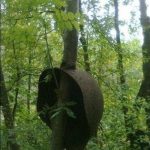 absorbed the foreign object. Even then, the tree could not fully absorb the helmet, and so it looked almost like the tree was wearing the helmet on its knotted head…and the branches protruding from the knot looked like messy hair. The strange looking trees, were a lingering reminder of a war that was long over, but somehow not forgotten…and nature prevails.
absorbed the foreign object. Even then, the tree could not fully absorb the helmet, and so it looked almost like the tree was wearing the helmet on its knotted head…and the branches protruding from the knot looked like messy hair. The strange looking trees, were a lingering reminder of a war that was long over, but somehow not forgotten…and nature prevails.
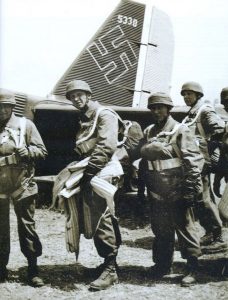 Every new for of weapon or battle plan must have a first time of use. I don’t know if the soldiers or the inventors would be more nervous as this plan unfolded, but my guess is the soldiers, who must place their lives in the hands of the inventor, and pray that he knew what he was doing. The Battle of Crete, also known as Operation Mercury was fought during World War II on May 20, 1941 to May 21, 1941. It was short-lived mostly because of the “firsts” the Allies saw during this battle.
Every new for of weapon or battle plan must have a first time of use. I don’t know if the soldiers or the inventors would be more nervous as this plan unfolded, but my guess is the soldiers, who must place their lives in the hands of the inventor, and pray that he knew what he was doing. The Battle of Crete, also known as Operation Mercury was fought during World War II on May 20, 1941 to May 21, 1941. It was short-lived mostly because of the “firsts” the Allies saw during this battle.
On that day, May 20, 1941, the Nazis began an airborne invasion of the island of Crete. Greek forced were joined by other Allied troops to defend the island. After one day of fighting, the Germans appeared to be losing, as they had suffered heavy casualties. This gave the Allies a feeling of confidence in their victory over the Nazis. Unfortunately that feeling of confidence was a little premature. The next day, the Allies encountered some communication failures, and due to the Allied tactical hesitation, as 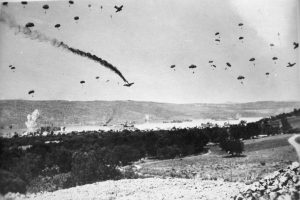 well as German offensive operations, Maleme Airfield in western Crete fell to the Germans. This enabled the Germans to land reinforcements and overwhelm the defensive positions on the north side of the island. The Allied forces had no choice but to withdrew to the south coast. More than half of them were evacuated by the British Royal Navy, but the remainder surrendered or joined the Cretan resistance. The defense of Crete evolved into a costly naval engagement, and by the end of the campaign the Royal Navy’s eastern Mediterranean strength had been reduced to only two battleships and three cruisers…not enough to defend anything.
well as German offensive operations, Maleme Airfield in western Crete fell to the Germans. This enabled the Germans to land reinforcements and overwhelm the defensive positions on the north side of the island. The Allied forces had no choice but to withdrew to the south coast. More than half of them were evacuated by the British Royal Navy, but the remainder surrendered or joined the Cretan resistance. The defense of Crete evolved into a costly naval engagement, and by the end of the campaign the Royal Navy’s eastern Mediterranean strength had been reduced to only two battleships and three cruisers…not enough to defend anything.
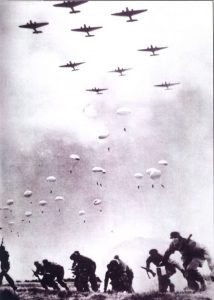
So…what made this an operation of firsts? The Battle of Crete was the first time that German paratroops, known as Fallschirmjäger, were used en masse. It was also the first mainly airborne invasion in military history, and the first time the Allies made significant use of intelligence from decrypted German messages from the Enigma machine. It was also the first time German troops encountered mass resistance from a civilian population. Prior to this time the Nazis held enough power over the civilians to force them to comply. These people fought back…for the first time. Due to the number of casualties and the belief that airborne forces no longer had the advantage of surprise, Adolf Hitler became reluctant to authorize further large airborne operations, preferring instead to employ paratroopers as ground troops. In contrast, the Allies were impressed by the potential of paratroopers and started to form airborne-assault and airfield-defense regiments of their own. Major changes in military history, brought about by one battle.
 I think that anyone who has studied the Civil War, knows that it got started when the Confederates attacked Fort Sumter on April 12, 1861…officially anyway. Of course, the Civil War was all about slavery, and the North and South could not agree on the issue. As with all wars, there was some posturing before the war actually got started. Each side tries to scare the other into compliance, but sometimes that just doesn’t work out. The strange thing about the Civil War was that the “posturing stage” of the war ended up being a comedy of errors, when an inexperienced gunner accidently discharged his cannon into the fort on March 12, 1861. After the error, in which no one was hurt or killed, thankfully, the Confederates had to row over and apologize for the mistake. That strikes me as really funny, because everyone knew the war was coming, but just not when it would start.
I think that anyone who has studied the Civil War, knows that it got started when the Confederates attacked Fort Sumter on April 12, 1861…officially anyway. Of course, the Civil War was all about slavery, and the North and South could not agree on the issue. As with all wars, there was some posturing before the war actually got started. Each side tries to scare the other into compliance, but sometimes that just doesn’t work out. The strange thing about the Civil War was that the “posturing stage” of the war ended up being a comedy of errors, when an inexperienced gunner accidently discharged his cannon into the fort on March 12, 1861. After the error, in which no one was hurt or killed, thankfully, the Confederates had to row over and apologize for the mistake. That strikes me as really funny, because everyone knew the war was coming, but just not when it would start.
All that “practice” apparently didn’t help either, because when the war actually started, they fired over 3,000  shells at the fort without injuring a single Union soldier. Nevertheless, the men at the fort were apparently intimidated, because they surrendered and a Confederate officer named Roger Pryor rowed out to negotiate the terms. As the discussion progressed, Pryor casually got up, poured himself a glass of whiskey. Probably not the best idea. He downed it in one gulp, before finding out that it was actually a bottle of medical iodine that happened to be nearby. Pryor’s “Three Stooges” moment ended with army doctors frantically pumping his stomach while nervous Union officers wondered how they were going to explain poisoning the negotiator. I can see it all now. The Union doctors were scrambling to save Pryor’s life, all the while thinking that the Confederate soldiers were going to accuse them of trying to murder him. Fortunately, Pryor survived, but the comedy of errors did not end there. In what would become one last screw-up, and to mark the surrender, the Union commander ordered his gunners to fire a salute. Once again, the “training” given was lacking or the soldiers were just careless. The gunners piled cartridges next to
shells at the fort without injuring a single Union soldier. Nevertheless, the men at the fort were apparently intimidated, because they surrendered and a Confederate officer named Roger Pryor rowed out to negotiate the terms. As the discussion progressed, Pryor casually got up, poured himself a glass of whiskey. Probably not the best idea. He downed it in one gulp, before finding out that it was actually a bottle of medical iodine that happened to be nearby. Pryor’s “Three Stooges” moment ended with army doctors frantically pumping his stomach while nervous Union officers wondered how they were going to explain poisoning the negotiator. I can see it all now. The Union doctors were scrambling to save Pryor’s life, all the while thinking that the Confederate soldiers were going to accuse them of trying to murder him. Fortunately, Pryor survived, but the comedy of errors did not end there. In what would become one last screw-up, and to mark the surrender, the Union commander ordered his gunners to fire a salute. Once again, the “training” given was lacking or the soldiers were just careless. The gunners piled cartridges next to  their cannons…in a high wind. The resulting explosion killed two of their own men, the only casualties of the siege.
their cannons…in a high wind. The resulting explosion killed two of their own men, the only casualties of the siege.
The war had at least one other comedy of errors, this time in Congress. In 1858, tensions between pro-slavery and anti-slavery factions were so heated that a huge brawl broke out between at least 30 Congressmen on the House floor. This was not just an argument, it was a brawl, and it only came to an end when Mississippi’s William Barksdale had his wig knocked off. Since Barksdale never admitted to wearing a wig, he quickly snatched it back up and put it on inside out, causing everyone to stop fighting and start laughing instead. Barksdale didn’t think it funny, but I do.
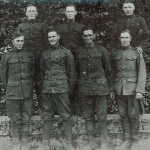 This day…Armistice Day was sometimes called the end of the war to end all wars. The phrase came from a book, and was really an idealistic statement, because as we all know there will always be a war somewhere. Nevertheless, it must have been overwhelming to think of basically the whole world at war. I’m sure the writer of the book, H G Wells, as well as many other people, hoped that through this awful war, humans could somehow learn to live with one another in peace. While that was not to be, this war, like every war, finally comes to an end. Armistice Day marks the armistice signed between the Allies of World War I and Germany at Compiègne, France, for the cessation of hostilities on the Western Front of World War I, which took effect at eleven o’clock in the morning, on the “eleventh hour of the eleventh day of the eleventh month” of 1918. That was, of course, 100 years ago today. Armistice Day is a national holiday in France. It coincides with Remembrance Day in England, and Veterans Day in the United States, and all three are really commemorating the same thing…the end of World War I. And all three are observed as a time to remember those heroes who served their country in that and all other wars. It is a day to remember those who fought and
This day…Armistice Day was sometimes called the end of the war to end all wars. The phrase came from a book, and was really an idealistic statement, because as we all know there will always be a war somewhere. Nevertheless, it must have been overwhelming to think of basically the whole world at war. I’m sure the writer of the book, H G Wells, as well as many other people, hoped that through this awful war, humans could somehow learn to live with one another in peace. While that was not to be, this war, like every war, finally comes to an end. Armistice Day marks the armistice signed between the Allies of World War I and Germany at Compiègne, France, for the cessation of hostilities on the Western Front of World War I, which took effect at eleven o’clock in the morning, on the “eleventh hour of the eleventh day of the eleventh month” of 1918. That was, of course, 100 years ago today. Armistice Day is a national holiday in France. It coincides with Remembrance Day in England, and Veterans Day in the United States, and all three are really commemorating the same thing…the end of World War I. And all three are observed as a time to remember those heroes who served their country in that and all other wars. It is a day to remember those who fought and 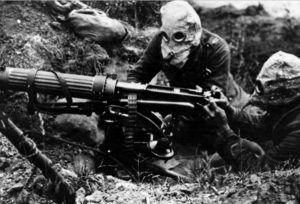 then returned home, but we can’t forget those who didn’t return home either.
then returned home, but we can’t forget those who didn’t return home either.
Because World War I ended on November 11, 1918, we have continued to remember November 11 as Veterans Day, Armistice Day, and Remembrance Day in honor of our soldiers. The armistice initially expired after a period of 36 days. A formal peace agreement was only reached when the Treaty of Versailles was signed the following year, but the Armistice was the beginning. It paved the way, and sometimes that is what is needed the most at a certain low time in history, or in life. Just a glimmer of hope can change the way we feel about things in a big way. It doesn’t matter what name is attached to the day, its all about the meaning of the day that matters. Our veterans have done so much for people they don’t even know, and they all deserve to be recognized for their very heroic acts.
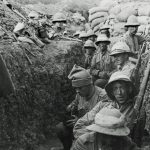 The date is a national holiday in France, England, the United States, and was also declared a national holiday in many Allied nations. In some countries Armistice Day coincides with Remembrance Day and Veterans Day, and other public holidays. Armistice Day is not celebrated in Germany, but a German national day of mourning, Volkstrauertag, has been observed on the Sunday closest to 16 November since 1952. However the day is observed, it is always a day to remember the sacrifice of our soldiers. The day is always celebrated as a day to honor those who served. We can all relate to that, because we all know a veteran, and we all consider them to be honorable people. So, no matter how each country celebrates it or what they call it, we honor our veterans today. Happy Veterans Day!!
The date is a national holiday in France, England, the United States, and was also declared a national holiday in many Allied nations. In some countries Armistice Day coincides with Remembrance Day and Veterans Day, and other public holidays. Armistice Day is not celebrated in Germany, but a German national day of mourning, Volkstrauertag, has been observed on the Sunday closest to 16 November since 1952. However the day is observed, it is always a day to remember the sacrifice of our soldiers. The day is always celebrated as a day to honor those who served. We can all relate to that, because we all know a veteran, and we all consider them to be honorable people. So, no matter how each country celebrates it or what they call it, we honor our veterans today. Happy Veterans Day!!
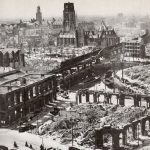 After World War II, most of Europe was in a big mess, whether it was the land,the cities and towns, or the government. There were scores of dead people around, countries and borders were torn apart, most of Europe had been “ground into a very civilized kind of pudding…and the USSR was knocking on the door to come and raid the fridge…so to speak.” Russia would have loved to sneak in and take over when they were at their most vulnerable. The people looked to the United States to figure out away to keep them safe, but not to occupy their countries, per se. That is a rather tall order, but one that the United States took seriously.
After World War II, most of Europe was in a big mess, whether it was the land,the cities and towns, or the government. There were scores of dead people around, countries and borders were torn apart, most of Europe had been “ground into a very civilized kind of pudding…and the USSR was knocking on the door to come and raid the fridge…so to speak.” Russia would have loved to sneak in and take over when they were at their most vulnerable. The people looked to the United States to figure out away to keep them safe, but not to occupy their countries, per se. That is a rather tall order, but one that the United States took seriously.
So the United States came up with Operation Gladio. Basically, they installed a secret military that would unofficially operate all across Europe. The secret military would have one and only one goal…combating communism. Little is known about this secret military, even today, because it wouldn’t be a very good secret army if we knew all about them. So, facts are pretty limited, but it’s not some crazy theory either. Their existence has been confirmed, and the network has been associated with such high-stakes super-evil events, as an attempted pope assassination, large scale bombings, and kidnappings of several high-level government officials. They were willing to do anything to fight communism…murder, extortion, even seemingly becoming communists, if that’s what it took. It turns out that the Italian branch was a particularly active group. An entirely different president of Italy, Francesco Cossiga, was involved in this ominous anti-communism secret society. The reason we don’t know more about them, even years after the end of the Cold War, is simple: crazy, crazy murders. Their secrets will follow them to the grave.
Then a new Italian president was elected. President Aldo Moro, wanted to allow communists to run for office.The still operating Gladio could not let this happen. He was suddenly kidnapped and eventually executed.  His body was found in the trunk of a car parked next to an ancient gladiatorial site. A warning to others…more than probably!! A “gladio” is an ancient Roman short sword, used in arena combat. A former colonel of Gladio operations in Switzerland decided to write a letter to the government stating that he was ready to “reveal the whole truth.” Again, Operation Gladio took action. The Gladio colonel was found dead in his home a month later. He was stabbed to death with his own bayonet. There were a series of mysterious characters written on his chest that couldn’t be deciphered. Of course, that’s not concrete evidence of Gladio’s direct involvement in these events, but these are just two brutal, worrying events that spin a web of mystery and fear that keeps further investigations from being opened. Sometimes, it’s best to let sleeping dogs lie.
His body was found in the trunk of a car parked next to an ancient gladiatorial site. A warning to others…more than probably!! A “gladio” is an ancient Roman short sword, used in arena combat. A former colonel of Gladio operations in Switzerland decided to write a letter to the government stating that he was ready to “reveal the whole truth.” Again, Operation Gladio took action. The Gladio colonel was found dead in his home a month later. He was stabbed to death with his own bayonet. There were a series of mysterious characters written on his chest that couldn’t be deciphered. Of course, that’s not concrete evidence of Gladio’s direct involvement in these events, but these are just two brutal, worrying events that spin a web of mystery and fear that keeps further investigations from being opened. Sometimes, it’s best to let sleeping dogs lie.
 After the August 18, 1976 ace murder of two United States Army officers, Captain Arthur Bonifas and Lieutenant Mark Barrett, by North Korean soldiers, in the Joint Security Area located in the North Korean Demilitarized Zone, it was decided that something had to be done about a certain poplar tree that blocked the view of UN observers, allowing them to be assaulted and killed by the North Koreans, who claimed that the tree had been planted by Kim Il-Sung. It was dubbed the Panmunjom axe murder incident, and it was infuriating to the United States.
After the August 18, 1976 ace murder of two United States Army officers, Captain Arthur Bonifas and Lieutenant Mark Barrett, by North Korean soldiers, in the Joint Security Area located in the North Korean Demilitarized Zone, it was decided that something had to be done about a certain poplar tree that blocked the view of UN observers, allowing them to be assaulted and killed by the North Koreans, who claimed that the tree had been planted by Kim Il-Sung. It was dubbed the Panmunjom axe murder incident, and it was infuriating to the United States.
Three days later, American and South Korean forces launched Operation Paul Bunyan. There was one objective to Operation Paul Bunyan…cut down the tree with a show of force to intimidate North Korea into backing down. Operation Paul Bunyan was carried out on August 21 at 07:00, three days after the killings. A convoy of 23 American and South Korean vehicles, known as “Task Force Vierra”, named after Lieutenant Colonel Victor Vierra, commander of the United States Army Support Group, drove into the JSA without any warning to the North Koreans. There was just one observation post manned at that hour. The vehicles contained two eight-man teams of military engineers from the 2nd Engineer Battalion, 2nd Infantry Division, equipped with chain-saws to cut down the tree. Accompanying these teams were two 30-man security platoons from the Joint Security Force, who were armed with pistols and axe handles. The 1st Platoon secured the northern entrance to the JSA via the Bridge of No Return, while the 2nd Platoon secured the southern edge of the area. A team from B Company, commanded by Captain Walter Seifried, activated the detonation systems for the charges on Freedom Bridge and had the 165mm main gun of the M728 combat engineer vehicle aimed mid-span to ensure that the bridge would fall should the order be given for its destruction.
B Company, supporting E Company (bridge), were building M4T6 rafts on the Imjin River should the situation require emergency evacuation by that route. An additional 64-man task force of the South Korean Special Forces accompanied them, armed with clubs and trained in Tae Kwon Do, supposedly without firearms. Once 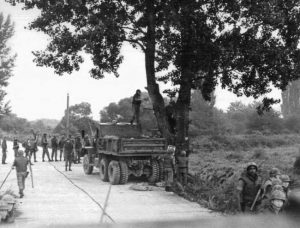 they parked their trucks near the Bridge of No Return, however, they started throwing out the sandbags that lined the truck bottoms, and handing out M16 rifles and M79 grenade launchers that had been concealed below. Several of the commandos also had M18 Claymore mines strapped to their chests with the firing mechanism in their hands, and were shouting at the North Koreans to cross the bridge. A U.S. Infantry company in 20 utility helicopters and seven Cobra attack helicopters circled behind them. Behind these helicopters, B-52 Stratofortresses, came from Guam escorted by US F-4 Phantom IIs from Kunsan Air Base and South Korean F-5 and F-86 fighters were visible flying across the sky at high altitude. At Taegu Air Base, F-111 bombers of the 366th Tactical Fighter Wing out of Mountain Home Air Force Base, were stationed, and F-4 Phantoms C and D from the 18th TFW Kadena Air Base and Clark Air Base were also deployed. The aircraft carrier USS Midway task force had also been moved to a station just offshore. Near the edges of the DMZ, many more heavily armed U.S. and South Korean infantry, artillery including the Second Battalion, 71st Air Defense Regiment armed with Improved Hawk missiles, and armor were waiting to back up the special operations team. Bases near the DMZ were prepared for demolition in case of a military response. The defense condition (DEFCON) was elevated on order of General Stilwell, as recounted in Colonel De LaTeur’s research paper later. 12,000 additional troops were ordered to Korea, including 1,800 Marines from Okinawa. During the operation, nuclear-capable strategic bombers circled over the JSA. According to an intelligence analyst monitoring the North Korea tactical radio net, the accumulation of force “blew their… minds.” Altogether, Task Force Vierra consisted of 813 men: almost all of the men of the United States Army Support Group, of which the Joint Security Force was a part; a South Korean reconnaissance company; a South Korean Special Forces company which had infiltrated the river area by the bridge the night before; and members of a reinforced composite rifle company from the 9th Infantry Regiment. In addition to this force, every UNC force in the rest of South Korea was on battle alert.
they parked their trucks near the Bridge of No Return, however, they started throwing out the sandbags that lined the truck bottoms, and handing out M16 rifles and M79 grenade launchers that had been concealed below. Several of the commandos also had M18 Claymore mines strapped to their chests with the firing mechanism in their hands, and were shouting at the North Koreans to cross the bridge. A U.S. Infantry company in 20 utility helicopters and seven Cobra attack helicopters circled behind them. Behind these helicopters, B-52 Stratofortresses, came from Guam escorted by US F-4 Phantom IIs from Kunsan Air Base and South Korean F-5 and F-86 fighters were visible flying across the sky at high altitude. At Taegu Air Base, F-111 bombers of the 366th Tactical Fighter Wing out of Mountain Home Air Force Base, were stationed, and F-4 Phantoms C and D from the 18th TFW Kadena Air Base and Clark Air Base were also deployed. The aircraft carrier USS Midway task force had also been moved to a station just offshore. Near the edges of the DMZ, many more heavily armed U.S. and South Korean infantry, artillery including the Second Battalion, 71st Air Defense Regiment armed with Improved Hawk missiles, and armor were waiting to back up the special operations team. Bases near the DMZ were prepared for demolition in case of a military response. The defense condition (DEFCON) was elevated on order of General Stilwell, as recounted in Colonel De LaTeur’s research paper later. 12,000 additional troops were ordered to Korea, including 1,800 Marines from Okinawa. During the operation, nuclear-capable strategic bombers circled over the JSA. According to an intelligence analyst monitoring the North Korea tactical radio net, the accumulation of force “blew their… minds.” Altogether, Task Force Vierra consisted of 813 men: almost all of the men of the United States Army Support Group, of which the Joint Security Force was a part; a South Korean reconnaissance company; a South Korean Special Forces company which had infiltrated the river area by the bridge the night before; and members of a reinforced composite rifle company from the 9th Infantry Regiment. In addition to this force, every UNC force in the rest of South Korea was on battle alert.

All this to cut down one tree!! My first thought on all this was…overkill, to the extreme!! That’s what I thought at first, but after researching the operation more, I realized that this was as much a show of force, as it was a way to cut down a tree that was really blocking a view that was necessary for keeping soldiers safe. North Korea needed to be shown what could come of such an attack, should it ever happen again. And it worked…North Korea accepted responsibility for the earlier killings. The incident is also known alternatively as the hatchet incident, the poplar tree incident, and the tree trimming incident. Final loss of life, two American Army officers, and one poplar tree.

